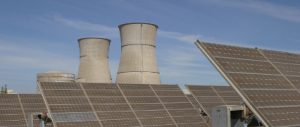Europe’s vision of a giant solar-thermal plant in the Sahara Desert, meeting up to 15% of the continent’s electricity needs, is frequently dismissed as outlandish fantasy. But China is gearing up to attempt to make a similar dream come true. Following a series of delays and setbacks, plans to build a solar-thermal plant in Ordos, Inner Mongolia – and mark the start of a new era for the technology in China – are moving forward.
It looks like the two forms of solar power, thermal and photovoltaic, are set to compete on the same stage. In broad terms, photovoltaic technology uses solar cells to convert sunlight into electricity, while solar-thermal systems concentrate sunlight using mirrors or lenses in order to produce steam and drive power-generating turbines.
The moment the Ordos project was announced, Yao Zhihao, assistant to the director of the Chinese Academy of Sciences’ solar-thermal and photovoltaic systems laboratory, had just returned from submitting China’s application for membership to a key body – the International Solar Power and Chemical Energy Systems (SOLARPaces) group. The organisation, which is managed under the umbrella of the International Energy Agency (IEA), currently has 16 member nations, almost all of them western.
In May, the IEA released two reports advocating solar power. The organisation was particularly enthusiastic about solar-thermal energy, saying it would solve power-storage issues without increasing grid load. Overnight, manufacturers, generators and investors turned their attention to this hitherto widely overlooked technology. Most of the world’s existing solar-power plants use photovoltaic technology and, while hundreds of megawatts of solar-thermal capacity are under construction globally, development of the technology in China has been limited to single-megawatt scale pilot projects. Not too long ago, it was simply restricted to the laboratory.
In 2009, a solar-thermal taskforce under the Ministry of Science and Technology was set up to tackle technological roadblocks. The 41 corporate, university and institutional members of the group include the Institute of Electrical Engineering (IEE) at the Chinese Academy of Sciences, Huadian, Himin Solar, the Jinjing Group, Xi’an Aero-Engine Group and the China Power Engineering Consulting Group.
By then, China’s five major power firms had already started dipping their toes into solar-thermal waters. Huadian has facilities in the western provinces of Xinjiang, Gansu and Qinghai and, in the northern province of Hebei, an experimental base in trough style solar-thermal power, where sunlight is concentrated onto insulated tubes. China Guodian has a small 180-kilowatt trial project in Turpan in Xinjiang, where power generation is due to start in 2011. And Baoding Tianwei plans to build a 100 megawatt solar-thermal plant in Sichuan.
Wang Xinwei, public education official with the IEE’s solar-thermal laboratory, recalls that, in 2009, the “big five” power firms started paying frequent visits, hoping to become shareholders in generating projects. A long absent enthusiasm for solar-thermal investment emerged in spades.
Secretary of the Solar Thermal Alliance Shao Jixin told Southern Weekend that, according to the organisation’s incomplete statistics, China now has some 4,000 megawatts of solar-thermal capacity in the planning, feasibility, funding or construction stages. Of this, 1,950 megawatts were proposed in 2009 and the remainder in 2010. Globally, there is around 1,000 megawatts of solar-thermal capacity in operation. As of April 2009, a further 1,200 megawatts-worth was under construction. And the figures are changing all the time.
Shao went on to explain that, as part of the Ministry of Science and Technology’s “863 High-Technology Project”, a programme that promotes technological advancement, real progress has been made in sunlight-focusing techniques and equipment; high temperature heat transmission and storage; and the design, assembly and control of power plants. And, as China can produce the key equipment and components of solar-thermal plants, its industrial chain is already almost complete. There is just one missing link – experience in operation of large-scale commercial demonstration plants.
Technological bottlenecks present an additional problem, however. Ma Dongfang, an energy-storage researcher at Beijing University of Technology, said that the vacuum tubes used in trough-style solar-thermal power – currently the most mature solar-thermal technique – frequently break. Each breakage requires the replacement of heat conducting oil, which costs 30,000 yuan (US$4,400) to 40,000 yuan (US$5,900) a tonne. So the technology is mature, but not yet ideal. Meanwhile, tower-style generation is less efficient, and parabolic-dish technology is still in the experimental stage.
Li Junfeng, deputy director of the National Reform and Development Commission’s Energy Research Institute, sees further technological limitations. Theoretically, solar-thermal energy stores power to meet peak demand. But there’s a catch – to do so, it requires auxiliary heat sources, such as natural gas or oil.
The plants also need to be built in desert areas, where the necessary sunlight, water and land are available. But in Inner Mongolia, where sandstorms are frequent, the motors rotating the mirrors and the mirrors themselves will need protection from the elements, presenting technological challenges. “Whether you are talking about California, North Africa, Spain, or anywhere else in the world, there isn’t a single ‘desert’ power plant that is actually built on a real desert. That’s a fact China’s solar-thermal industry has got to face up to,” said Li Junfeng.
Another such fact is that 15% of energy for heat storage in solar-thermal plants comes from oil or natural gas. The locations suitable for these solar installations are often distant from both cities and the power grid – and unlikely to be equipped with oil and gas facilities. In the 1990s, a solar-thermal plant in California was forced to close after its natural-gas supply was interrupted and the contents of its molten-salt furnace cooled and solidified. “The most important issue is that China still lacks solar-thermal energy experts and a complete industrial chain and does not yet have a fully integrated plant,” said Li Junfeng. “Having a piece of cloth and knowing how to cut it and add buttons doesn’t make you a tailor.”
Solar-thermal energy has always been dogged by cost concerns. And, today, costs remain a deciding factor in its success or failure. Energy generated by the technology gets cheaper at a larger scale – the industry’s preferred size for a solar-thermal plant is currently 1,000 megawatts. At this point, electricity can be generated at a competitive rate of 0.70 yuan (US$0.10) to 0.80 yuan (US$0.12) per kilowatt hour.
But Li pointed out that, in Spain, the world’s largest producer of solar-thermal energy, the costs are still 3.3 yuan (US$0.49) per kilowatt hour. Even taking into account the lower costs of production in China, that figure is only likely to fall to about 2 yuan (US$0.30). China’s Solar Thermal Alliance retorted that the latest figures show costs in Spain have actually fallen to 2 yuan (US$0.30) per kilowatt hour. But even at this price, the technology would fail to compete with China’s first photovoltaic concession, the 10 megawatt project in Dunhuang, Gansu province, which has costs as low as 1.09 yuan (US$0.16) per kilowatt hour.
Jiang Qian, senior energy researcher at intelligence provider China Investment Consulting, told Southern Weekend that solar-thermal energy in the United States costs US$0.13 (0.88 yuan) to U$0.16 (1.08 yuan) per kilowatt hour – close to the costs of wind power and with huge potential for reductions. And although photovoltaic costs have fallen greatly, they are currently holding at about US$0.25 (1.69 yuan) per kilowatt hour. The US Department of Energy aims to drive solar-thermal energy costs down from the current average of US$0.14 (0.95 yuan) per kilowatt hour to US$0.08 to US$0.10 (0.54 yuan to 0.68 yuan) by 2015. And such a trend could see solar-thermal energy trump its photovoltaic cousin.
One official from China’s National Development and Reform Commission offered a cautious view, however, saying that the photovoltaic sector has already gone through several years of industrialisation and seen costs fall rapidly. As for solar thermal energy? “Give it a few more years to develop, and then we’ll see.”
Feng Jie is a Southern Weekend reporter and Chen Zhou an intern. This article was first published in Southern Weekend on July 1.
Homepage image by Charlie Brewer



